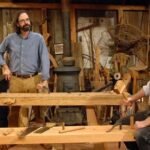A Cup of Coffee and a Japanese Tool Story
You know, there’s something magical about the smell of freshly cut wood. It reminds me of my dad’s workshop back in Iowa, where I grew up surrounded by sawdust and the echo of hammers striking nails. There’s this warmth that comes with a good woodworking project, but let me tell you, not everything goes as planned.
Now, if you’ve ever dabbled in woodworking—especially using that fancy Japanese stuff—you’ll know it’s a bit of a rabbit hole. I mean, wow, there’s a world of difference between a Western hand saw and a Japanese one, and not just in how they look. Last summer, I decided to really dive into this whole Japanese woodworking thing. I was in San Francisco visiting some friends, and of course, I had to pop into a local tool shop.
It was one of those places that looked like it hadn’t changed in decades—wooden floors creaking beneath my feet, the walls lined with rustic shelving, and the air thick with that comforting woodiness that I’d grown up loving. I remember holding this elegant little saw, a Ryoba, and just marveling at the craftsmanship. It was beautiful, almost too beautiful to use, but I could feel my fingers itching to get it into my hands.
The First Cut
Fast forward a couple of weeks, and I’m back home, staring at a pile of ash wood I’d picked up from a local lumber yard. I had grand plans—something simple for my living room, maybe a bookcase to fit my ever-growing collection of history books, or at least that’s what I told myself. Honestly, I almost always needed a new home for my books.
So there I am, thinking I have it all figured out. I grabbed that Ryoba, which I’ve affectionately named “Ryobi,” and set to work. I remember the sound of the saw gliding through the wood. It was this smooth, rhythmic dance, and for about five minutes, I felt like a pro. I even caught myself grinning like a fool. Moments like that make you think, “Yes! I’ve got this!”
But then, as always seems to happen with me, it went sideways pretty quick. I was so focused on that saw, about how pretty it looked slicing through the grain, that I wasn’t paying attention to where the cut was going. Suddenly, the wood shifted, and I ended up with this weird crooked cut instead of the straight line I’d envisioned. The bookcase was effectively ruined.
An Oh-So-Classic Mistake
At that moment, I almost gave up. I swear, I stood there, staring at the board like it was going to magically realign itself. I even contemplated tossing the whole project aside, but then I took a deep breath. Hadn’t I read somewhere that mistakes are just another part of the woodworking process?
So, I grabbed my coffee, sat down for a moment, and thought, “Okay, what can I do with this?” I dusted off a little corner of my workbench, pulled up a chair, and started sketching. I mean, why not turn this crooked cut into a feature instead of a flaw? So there I was, sketching and sipping on my coffee like some artsy woodworker in a film.
Eventually, I came up with this idea for a sort of corner shelf thing. I’d never built anything like it before, but it felt exciting. The crooked edge would actually make it a little unique, you know? So I grabbed my chisel—oh man, there’s a whole different kind of love when you use a good Japanese chisel, that soft thud it makes on the wood, like a gentle reminder of who’s in charge.
With each tap, I started refining that mess. Before you know it, I was in the flow; the mistakes had become something that added character to my project. And the smell of the ash wood was intoxicating, filling the garage and curling around me like a familiar hug.
The Surprises Along the Way
You know what’s funny? Just when I thought I’d hit a stride, the next hurdle popped up. I was varnishing the thing to finish it off, and I forgot how quickly oil-based varnish dries. I looked away for a minute, and boom! Chunks of dust got stuck in the varnish. I felt like a total rookie—one more mistake in what should have been straightforward.
But instead of throwing a tantrum, I went for another cup of my favorite dark roast (I swear it’s my secret woodworking fuel), and thought about how to salvage it. Maybe I’d go for a distressed look? I took some sandpaper and eased into the grain again. What once seemed like a catastrophe turned into a sort of rustic charm that, believe it or not, I found to be… well, refreshing.
The Final Product
When I finally put that shelf together and placed it in a corner of my living room, I laughed. I mean, it looked nothing like what I had initially wanted, but honestly, it was a part of me. Each imperfection told its own story, just like I like to think every scar I carry does.
So here’s what I really want to say to you: if you’re thinking about diving into something like woodworking—especially with those fancy Japanese tools—just go for it. There’s beauty in the mess, in learning and making mistakes. Every chipped edge and crooked cut has a story that adds depth to your work. Don’t let that first rough cut dishearten you. If anything, it might inspire you to create something even better than you originally envisioned.
Pour yourself a cup of coffee and just start. You may surprise yourself.










